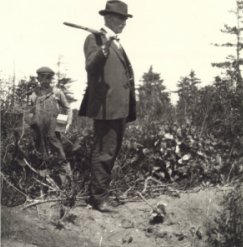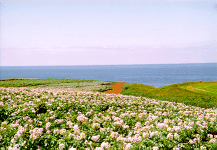
|
The Main Industries Of Tignish
Agriculture Although most of the early settlers eventually came to rely on the fishery as their primary means of earning a living, there were some early agricultural endeavours in the Tignish area. One of the first staple crops in Tignish was wheat. In 1856, the parishioners in Tignish contributed, in one day, one thousand bushels of wheat to finance the construction of a new church. It was, however, the British settlers who introduced the potato to the Island. At the beginning of the nineteenth century, wheat, barley and potatoes were being produced in Tignish in reasonable quantities.
Silver Fox The most important name associated with the silver fox industry is Sir Charles Dalton. As a young boy, he hunted and trapped black foxes. The first pair of Island black foxes used for breeding purposes in captivity were dug out of their den in 1870 at a place called "Fox Hill" in the Black Marsh, near North Cape, by a Caraquet fisherman named Thompson. Dalton eventually bought the pelts and sold them for $150. Dalton's first fox ranch was at "Savage Island" near Alberton with Robert T. Oulton as his partner. Dalton's ranch had about 500 foxes at one time. Ranchers came from far and wide- Japan, Holland and the Scandinavian countries; all were looking to buy "breeders."  Dalton's enterprise encouraged many others to take up the initiative. Eventually, Dalton sold out to his competitors, having made more than a million dollars for himself. Eventually the fashion world dictated the price of the silver fox pelt: no longer an essential fashion accessory, the sale of pelts began to dwindle. Eventually, the ranchers sold out, some at a heavy loss.  |
 Although many products are farmed around Tignish, the majority of farming is in potatoes and blueberries.
Potatoes are farmed all over the Island. However most potatoes are farmed east of Tignish.
Blueberries are harvested in Tignish between August and September. Blueberry rakes are used to scoop up the berries
and then the berries are dumped into a crate or bucket by workers. The farmers then process the
blueberries (remove leaves and dirt) and ship them to their customers.
Although many products are farmed around Tignish, the majority of farming is in potatoes and blueberries.
Potatoes are farmed all over the Island. However most potatoes are farmed east of Tignish.
Blueberries are harvested in Tignish between August and September. Blueberry rakes are used to scoop up the berries
and then the berries are dumped into a crate or bucket by workers. The farmers then process the
blueberries (remove leaves and dirt) and ship them to their customers.